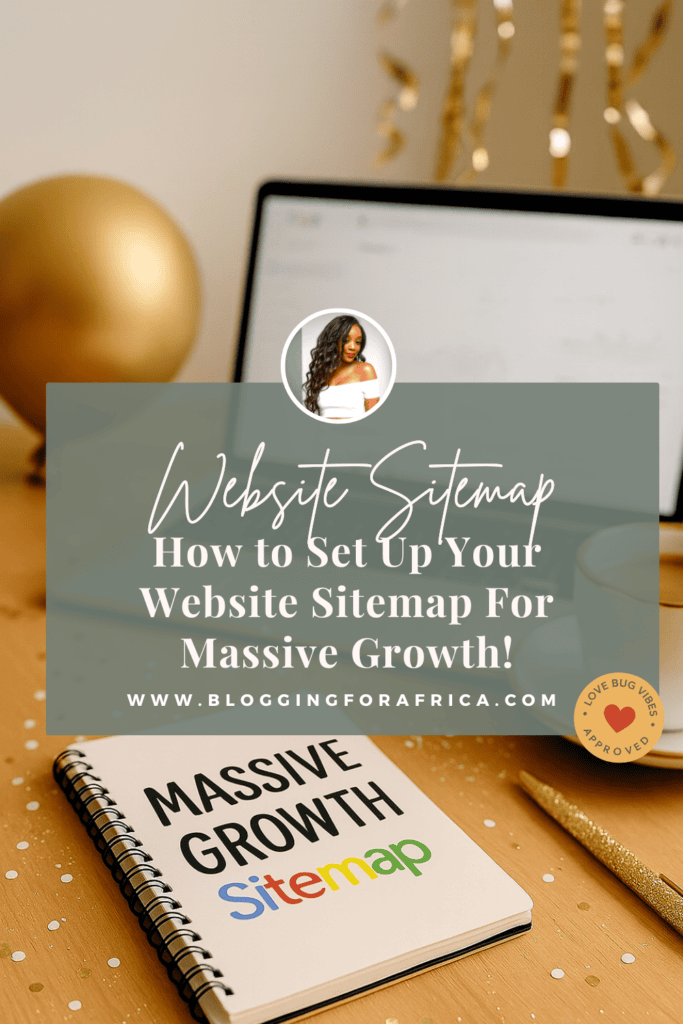How to Set Up Your Website Sitemap (and Why It Matters Big Time)
July 4, 2025

How to Set Up a Website Sitemap – and Why It Matters Big Time!
So you finally decided to take your website serious.
You don’t just want a pretty blog.
You want an effective, content-driven website that can actually grow your business.
You’re showing up.
You’re writing blog posts.
You mean business.
And now? You’re hoping Google takes notice — and treats your site like the real deal it is.
First things first
— great job, love bug 👏🏽
Those steps you’re taking? Total game changers 🔥
But let’s lock in one more piece of the puzzle — because the hustle is golden, but visibility is everything.
That’s where learning how to set up a website sitemap change the game.

Pin this for later, love bug 💛 You’ll be glad it’s there when tech gets tricky — and so will your audience. Trust me, they’ll thank you later.
If you want Google to not just see your website but also understand it — and rank it — you need to submit an official sitemap.
And yep, it’s as big of a deal as it sounds.
So You’re Probably Like, “Wait, What’s a Sitemap?”
A sitemap is basically a behind-the-scenes roadmap of your website that you send directly to Google.
Think of it like handing Google a special list of which pages matter most — a VIP checklist just for your site.
This list includes your most important pages: your homepage, blog, services, about page, landing pages — anything you want to rank.
This list helps Google crawl your site.
🕷 What Does “Crawling” Even Mean?
(And no, friend — it has nothing to do with icky bug stuff. Hehe.)
When I say “Google crawls your site,” here’s what that actually means:
Google uses bots (often called “spiders”) that scan websites to understand what’s on each page.
They follow links, read your content, and try to figure out how relevant each page is for searchers.
But here’s the catch — they don’t always magically know where to go.
Without a sitemap, your pages can get missed — especially new blog posts or landing pages that aren’t linked in obvious places.
👉🏽 For example: If you write a blog post but don’t link it anywhere on your website — like your homepage, blog page, or navigation bar — Google may never find it.
That’s why having a designated blog page (with your posts listed or linked) is so important. It tells Google, “This is where my new content lives.”
Can You Submit Blog Posts to Google Console Individually?
Yes — you can submit individual URLs to Google Search Console using the URL Inspection Tool.
It’s like tapping Google on the shoulder and saying, “Hey, I just published this — come crawl it.”
But here’s the thing:
* Submitting blog posts one by one can be helpful in the short term…
However, submitting your official website sitemap — from a designated blog page — gives Google a clearer, more consistent picture of your website as a whole to effectively crawl your site?
And in many cases, if you already have a designated blog page and a working sitemap, you may not need to manually submit every new blog post.
Google will likely find it on its own — faster and more reliably.
> If Google doesn’t crawl your site, it won’t get indexed.
> If it’s not indexed, it won’t show up in search.
> If it doesn’t show up in search… well, your audience won’t find you.
No ranking and stalled traffic?
You know what we say around here:
👇🏽
Ain’t nobody got time for that.
Sitemaps help you avoid that “no-traffic” horror story altogether.
How Google Knows Which Pages Matter Most
Once Google crawls your site, it organizes your content and stores it in its massive “library” of indexed pages.
Pages that live in your main navigation menu (like Home, Blog, or Services)?
Those are seen as more important.
That’s why site structure is a big deal.
But if you’ve got blog posts buried inside a category with no links pointing to them, there’s a real chance Google may never see them.
This is where your sitemap saves the day — making sure every page you care about gets the visibility it deserves.
So, How Much of a Difference Does a Sitemap Make?
Here’s the thing:
You don’t need a #1 ranking to be successful — but if that’s your goal, submitting a sitemap can help you get there a whole lot faster.
Like, by a LOT.
Here’s some data to consider:
Submitting a sitemap makes it easier for search engines to crawl your site efficiently — especially pages that aren’t easily linked. Source
A submitted sitemap helps Google discover your pages much faster — and in many cases, it’s the difference between getting found this week or next month. Source
(Yep, you read that right.)
Websites with clean sitemap structures tend to perform better in search — especially when paired with strong content and smart internal linking
So should you add a sitemap to your website?
Absolutely, like asap.
This Is What We Help Clients With 🥂
Inside our upcoming Global Blogging Business Packages, we’ll walk you through content strategy, site structure, and yes — sitemap setup too.
We’re building websites that aren’t just pretty — they’re primed for visibility.
If you’re ready for a content-driven website that grows with you — stay tuned. Details are coming soon 💻✨
But even if you’re not quite ready for a full package, I’ve still got you covered.
💛 Here’s a step-by-step visual tutorial: How to Submit a Sitemap to Google (Complete Guide)
*This one walks you through the exact steps to officially setup your sitemap inside Google Search Console.
Let’s make sure your content actually gets found.

✨ Psst… want to revisit this later?
Be sure to pin this guide on how to set up a website sitemap to your Pinterest board — it’s too good not to save 🧡
Ready to keep the momentum going?
Here are two other posts you’ll love:
📌 How to Submit a Sitemap to Google – A Step-by-Step Guide.
📌 Content-Driven Website Wins: 7 Hats You Can Finally Take Off.
📌 Content Creation Trends in 2025 – Smart Businesses Should Know.
Alright love bug, until next time!
Your favorite foodie and blogger, Keesh.
Was this post helpful? Don’t be shy, share it below! Your shares make a difference ♥️
For Global Business Owners & The Ambitious Creative Entrepreneur:
Unlock my Proven GAB-LC Method – A No-Fluff, Step-by-Step Strategy to Launch Your Blog, Increase Your Website Traffic, and Boost Product Sales - Get Your Free Blog Checklist & Take Action and Start Building Your Blog in Just 5 Days!
Leave a Reply Cancel reply
© 2024 Blogging For Africa All rights reserved Website Designed By Keesh
No Discrimination Policy
Contact
Unlock my Proven GAB-LC Method – A No-Fluff, Step-by-Step Strategy to Launch Your Blog, Increase Your Website Traffic, and Boost Product Sales - Get Your Free Blog Checklist & Take Action and Start Building Your Blog in Just 5 Days!
Enter email you would like information sent to.
Called To Blog
Free Blog Checklist
You're all signed up! Keep your eyes on your inbox for the information.